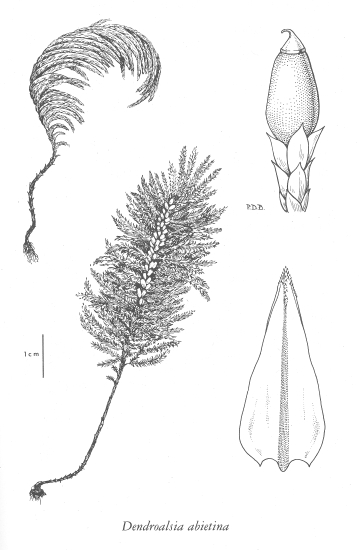Dendroalsia abietina (Hook.) Britt.
plume moss (dendroalsia moss)
Leucodontaceae
Species Account Author: Wilf Schofield
Extracted from Some Common Mosses of BC
Introduction to the Bryophytes of BC
plume moss (dendroalsia moss)
Leucodontaceae
Species Account Author: Wilf Schofield
Extracted from Some Common Mosses of BC
Introduction to the Bryophytes of BC
Species Information
Species description:
Genus name based on the tree-like outline of the branched shoots and the resemblance of the plants to the moss genus Alsia. Species name referring to the fancied resemblance of the plant outline to a fir tree (Abies).
Reproduction:
Sporophytes red-brown, frequent, maturing in late winter to early spring, arising on a short seta on the undersurface of the shoots. Male and female plants separate.
Distinguishing characteristics:
The distinctive dark green, epiphytic, miniature, feather-like plants are unlikely to be confused with any other moss in western North America. The dry, downward coiled plants are also characteristic.
Habit:
Forming extensive downward-pointing, dark green, densely pinnate shoots in which the lower portion of the shoot lacks branches; branches mainly arising in a single plane. Plants coiling downward toward the substratum when dry. Male plants usually with numerous lateral, bulb-like, sexual branches that are light green to straw-coloured.
Similar Species:
Some specimens of Isothecium stoloniferum, when moist and without sporophytes, occasionally resemble Dendroalsia, but I. stoloniferum is pale rather than dark green and the sporophytes arise on elongate setae from the upper surface of the main shoot.
Illustration

If more than one illustration is available for a species (e.g., separate illustrations were provided for two subspecies) then links to the separate images will be provided below. Note that individual subspecies or varietal illustrations are not always available.
Illustration Source: Some Common Mosses of BC
Habitat and Range
Habitat
Usually epiphytic, especially on tree trunks, most frequently on broad-leafed maple and Garry oak, but also on other trees, including poplar. Sometimes on somewhat shaded cliffsRange
World DistributionRestricted to western North America, reaching its northern limit in southern British Columbia, mainly near the coast, but found eastward to Idaho and southward to Baja California.